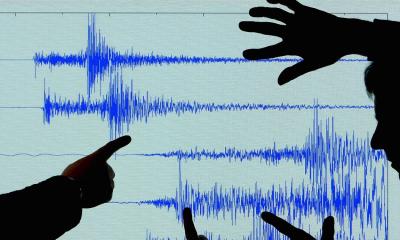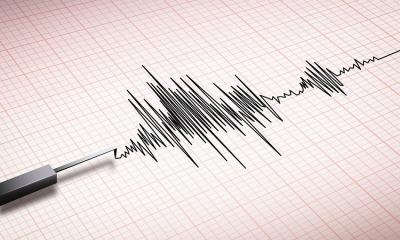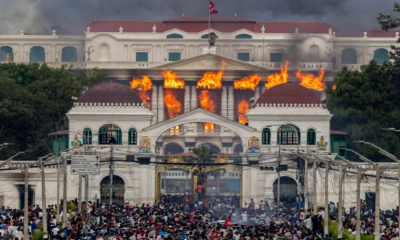In a stunning move made believable only by dint of being forewarned, US President Donald Trump on Wednesday announced far-reaching new tariffs on nearly all US trading partners — including a 34% tax on imports from China and 20% on the European Union, among others — that threaten to dismantle much of the architecture of the global economy and trigger broader trade wars.
Bangladesh got slapped with a whopping 37%, the Trump team`s calculation being that the country imposes 74% tariffs on imports from the US, that they then halved for many countries to arrive at ‘reciprocal’, because “we’re such nice people,” Trump said in his speech.
Currently most Bangladeshi goods are subjected to a 15% tariff on entry into the US market. The new rate is thus well over double the present rate.
The only consolation for Bangladesh might be that a number of its competitors fared worse. Vietnam got slapped with 46%, Cambodia 49%, Sri Lanka 44%. India and Pakistan fared slightly better though, at 26% and 29% respectively.
Trump, in a Rose Garden announcement, said he was placing elevated tariff rates on dozens of nations that run meaningful trade surpluses with the United States, while imposing a 10% baseline tax on imports from all countries in response to what he called an economic emergency.
The president, who said the tariffs were designed to boost domestic manufacturing, used aggressive rhetoric to describe a global trade system that the United States helped to build after World War II, saying “our country has been looted, pillaged, raped and plundered” by other nations.
The action amounts to a historic tax hike that could push the global order to a breaking point. It kickstarts what could be a painful transition for many Americans as middle-class essentials such as housing, autos and clothing are expected to become more costly, while disrupting the alliances built to ensure peace and economic stability.
Trump said he was acting to bring in hundreds of billions in new revenue to the U.S. government and restore fairness to global trade.
"Taxpayers have been ripped off for more than 50 years,” he said. “But it is not going to happen anymore.”
Trump declared a national economic emergency to levy the tariffs. He has promised that factory jobs will return to the United States as a result of the taxes, but his policies risk a sudden economic slowdown as consumers and businesses could face sharp price hikes.
Trump was fulfilling a key campaign promise as he imposed what he called “reciprocal” tariffs on trade partners, acting without Congress under the 1977 International Emergency Powers Act. But his action Wednesday could jeopardize Trump’s voter mandate in last year’s election to combat inflation. Several Republican senators, particularly from farm and border states, have questioned the wisdom of the tariffs. U.S. stock market futures sold off sharply overnight in anticipation of the economy weakening, after having already dropped since the start of this year.
"With today’s announcement, U.S. tariffs will approach levels not seen since the Smoot-Hawley Tariff Act of 1930, which incited a global trade war and deepened the Great Depression,” said Scott Lincicome and Colin Grabow of the Cato Institute, a libertarian think tank.
The president’s higher rates would hit foreign entities that sell more goods to the United States than they buy. The administration essentially calculated its tariff rates to raise revenues equal in size to the trade imbalances with those nations. Trump then halved that rate in an act that he described as “very kind.”
The White House says the tariffs and other trade imbalances led to an $1.2 trillion imbalance last year. Administration officials suggested it could take an extended set of actions by other countries to bring down the new tariffs their imports now face, and retaliatory tariffs by those countries could make the situation worse.
Canada and Mexico would not face higher rates on what they’re already being charged by Trump in what he says is an effort to stop illegal immigration and drug smuggling. As of now, goods that comply with the USMCA North American trade pact would be excluded from those tariffs.
But the 20% charged on imports from China due to its role in fentanyl production would largely be added to the 34% announced by Trump. The specific products that Trump is tariffing, such as autos, would be exempt from the tariffs unveiled Wednesday, as would products such as pharmaceutical drugs that he plans to tariff at a later date.
None of the warning signs about a falling stock market or consumer sentiment turning morose have caused the administration to publicly second-guess its strategy, despite the risk of political backlash.
Senior administration officials, who insisted on anonymity to preview the new tariffs with reporters ahead of Trump’s speech, said the taxes would raise hundreds of billions of dollars annually in revenues. They said the 10% baseline rate existed to help ensure compliance, while the higher rates were based on the trade deficits run with other nations and then halved to reach the numbers that Trump presented in the Rose Garden.
Allies brace themselves
Longtime trading partners are preparing their own countermeasures. Canada has imposed some in response to the tariffs that Trump tied to the trafficking of fentanyl. The European Union, in response to the steel and aluminum tariffs, put taxes on 26 billion euros ($28 billion) worth of U.S. goods, including on bourbon, which prompted Trump to threaten a 200% tariff on European alcohol.
Many allies feel they have been reluctantly drawn into a confrontation by Trump, who routinely says America’s friends and foes have essentially ripped off the United States with a mix of tariffs and other trade barriers.
The flip side is that Americans also have the incomes to choose to buy designer gowns by French fashion houses and autos from German manufacturers, whereas World Bank data show the EU has lower incomes per capita than the U.S.
The Chinese government delivered a measured response to the new tariffs, saying in a statement: “China believes that protectionism leads nowhere, and trade and tariff wars have no winners. This has been widely recognized in the international community.”



































